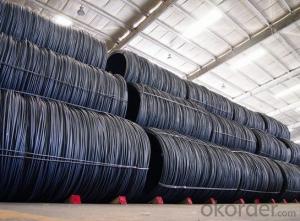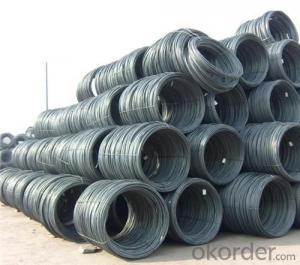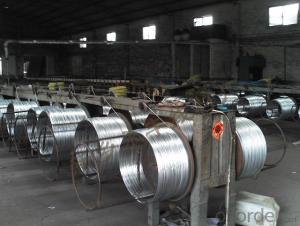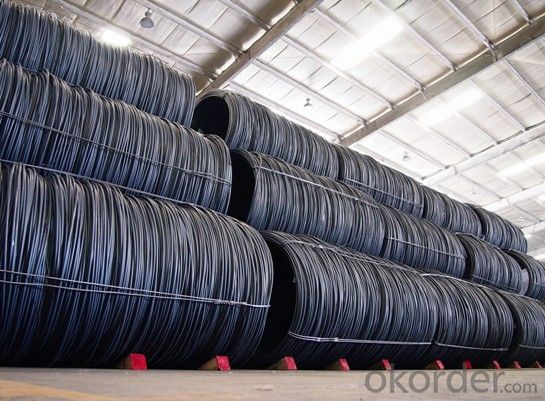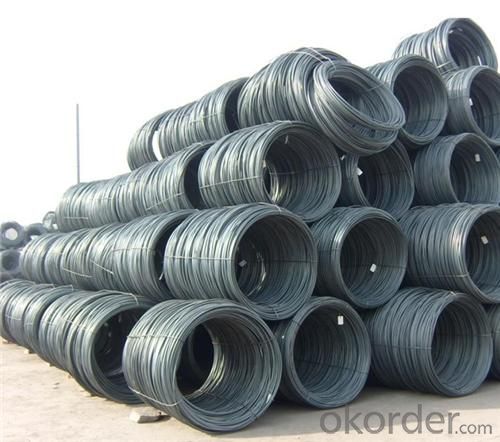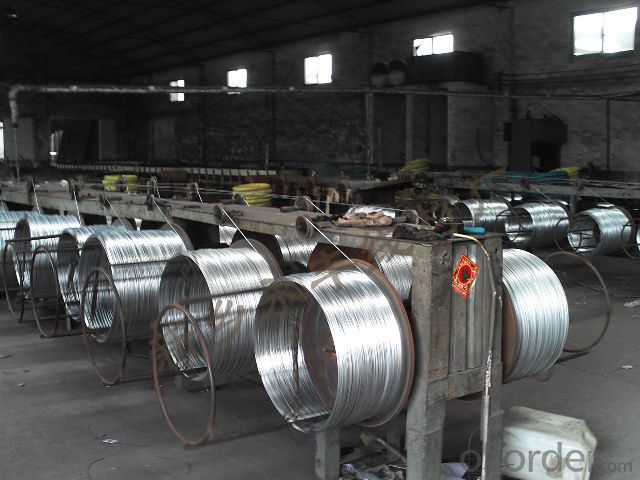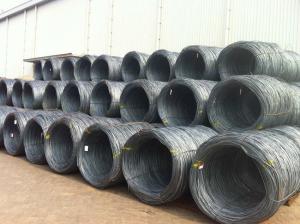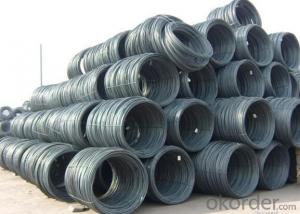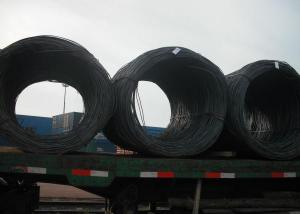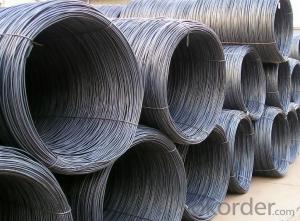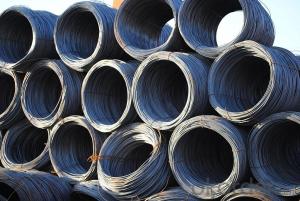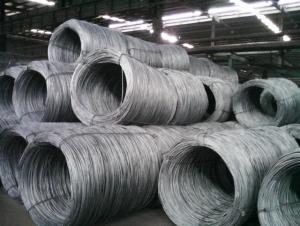Q195 low carbon wire galvanized steel wire rod
- Loading Port:
- Tianjin
- Payment Terms:
- TT OR LC
- Min Order Qty:
- 500 m.t.
- Supply Capability:
- 1000000 m.t./month
OKorder Service Pledge
OKorder Financial Service
You Might Also Like
1. Introduction:
.commodity:steel wire rod
.grade:Q195,SAE1008B-SAE1018B
.diameter:5.5mm-14mm
.type:in coil
.coil weight:around 2 mt
2. Specifications:
. Wire Gauge: 5.5mm, 6.5mm, 8mm, 9mm, 10mm, 11mm, 12mm
. Material: SAE1006, SAE1008,Q195,Q235,77B,82B
. Package: in coils
. Coil weight: 1.8-2.1 tons
. Application: Construction building, netting, package, rope and so on.
. The third party inspection: BV SGS China national construction steel quality supervision and test centre
3.Application:
Applicationwidely used in machinery parts, manufacturing industry, electronics industry, metal tools and others
4. Pictures


5.FAQ
We have organized several common questions for our clients,may help you sincerely:
①How about your company?
A world class manufacturer & supplier of castings forging in carbon steel and alloy steel,is one of the large-scale professional investment casting production bases in China,consisting of both casting foundry forging and machining factory. Annually more than 8000 tons Precision casting and forging parts are exported to markets in Europe,America and Japan. OEM casting and forging service available according to customer’s requirement.
②How to guarantee the quality of the products?
We have established the international advanced quality management system,every link from raw material to final product we have strict quality test;
- Q: What are the different hardness measurement methods for steel wire rod?
- There are several different methods used to measure the hardness of steel wire rods. These methods include: 1. Rockwell Hardness Test: This test measures the depth of penetration of an indenter into the material under a specified load. The Rockwell hardness scale is commonly used for steel wire rods due to its simplicity and versatility. 2. Brinell Hardness Test: In this test, a hardened steel ball is pressed into the surface of the wire rod under a known load. The hardness is determined by measuring the diameter of the indentation left by the ball. 3. Vickers Hardness Test: This test uses a square-based pyramid-shaped diamond indenter to make an indentation on the surface of the wire rod. The size of the indentation is measured and used to calculate the hardness. 4. Knoop Hardness Test: Similar to the Vickers test, the Knoop test uses a rhombic-based pyramid-shaped diamond indenter. It is particularly suitable for measuring the hardness of thin materials. 5. Microhardness Testing: This method involves measuring the hardness of small regions or specific areas on the wire rod using a microscope. It is often used to study the microstructure and hardness variations within the material. It is important to note that each hardness measurement method has its own advantages and limitations. The choice of method depends on the specific requirements and characteristics of the steel wire rod being tested.
- Q: How is steel wire rod used in the production of wire mesh for acoustic panels?
- Steel wire rod is used in the production of wire mesh for acoustic panels as it serves as the primary material for creating the mesh structure. The wire rod is typically drawn through a series of dies to obtain the desired diameter and then woven or welded together to form the wire mesh. This mesh provides the necessary support and stability to the acoustic panels, allowing sound waves to pass through while reducing noise and enhancing sound absorption.
- Q: What are the different types of steel wire rod surface defect visualization techniques?
- There are several techniques used for visualizing surface defects in steel wire rods. These include visual inspection, magnetic particle inspection, dye penetrant inspection, eddy current testing, ultrasonic testing, and X-ray inspection. Each technique has its own advantages and limitations, and the choice of technique depends on the specific requirements and characteristics of the steel wire rod being inspected.
- Q: How does the diameter of steel wire rod affect its strength?
- The diameter of a steel wire rod directly affects its strength. Generally, a larger diameter wire rod will have higher strength compared to a smaller diameter wire rod. This is because a larger diameter rod has a greater cross-sectional area, allowing it to withstand higher loads and stresses without breaking or deforming.
- Q: How is steel wire rod used in the manufacturing of automotive seat frames?
- Steel wire rod is commonly used in the manufacturing of automotive seat frames due to its high strength and durability properties. The steel wire rod is typically formed into different shapes and sizes to create the framework for automotive seats. These seat frames provide structural support and stability to the seats, ensuring they can withstand the weight and movements of passengers. The steel wire rod is first processed through various manufacturing techniques such as hot rolling, cold drawing, and heat treatment to achieve the desired mechanical properties. This process ensures that the steel wire rod has the necessary strength and flexibility to withstand the constant stress and load-bearing requirements of automotive seat frames. Once the steel wire rod is prepared, it is then bent and shaped into the required form using specialized machinery. This allows manufacturers to create different seat frame designs that meet the specific requirements of different vehicle models. The steel wire rod is often welded or joined together at specific points to form a sturdy and stable seat frame structure. The use of steel wire rod in automotive seat frames offers several advantages. Firstly, steel is known for its high strength-to-weight ratio, making it an ideal material for supporting heavy loads without adding excessive weight to the vehicle. Additionally, steel wire rod has excellent corrosion resistance properties, ensuring that seat frames remain durable and long-lasting even in harsh environmental conditions. Moreover, steel wire rod provides flexibility in design and customization. Manufacturers can easily modify the shape and size of the seat frames to accommodate various seat configurations and ergonomic requirements. This allows for the production of comfortable and safe seating options for passengers. In summary, steel wire rod is essential in the manufacturing of automotive seat frames due to its strength, durability, and customization capabilities. It provides the necessary structural support and stability to ensure the safety and comfort of vehicle occupants.
- Q: What are the different types of coatings for steel wire rod?
- Steel wire rods can be enhanced and safeguarded from corrosion through the application of various coatings. Some commonly employed coatings are as follows: 1. Zinc Coating: Galvanization, also known as zinc coating, is a highly favored option for steel wire rods. It ensures exceptional resistance against corrosion and can be applied using hot-dip galvanization or electroplating techniques. 2. Polymer Coating: Polymer coatings are often utilized to provide extra protection against corrosion and abrasion. These coatings can be applied through dip coating, extrusion, or powder coating methods, offering commendable adhesion and flexibility. 3. Phosphate Coating: Phosphate coatings are commonly employed as a pre-treatment for steel wire rods before the application of other coatings. They enhance the adhesion of subsequent coatings and improve corrosion resistance. 4. Epoxy Coating: Epoxy coatings are renowned for their exceptional adhesion and chemical resistance. They find frequent usage in industrial settings where the wire rods are exposed to harsh environments or corrosive substances. 5. Powder Coating: Powder coatings provide a robust and aesthetically pleasing finish to steel wire rods. These coatings are applied as dry powder and then cured under heat to create a smooth and protective layer. 6. Organic Coating: Organic coatings, such as acrylics or polyurethanes, are often employed for aesthetic purposes or to impart a specific color to the wire rods. These coatings also offer a certain degree of corrosion protection. 7. Ceramic Coating: Ceramic coatings find their application in high-temperature scenarios where the wire rods are subjected to extreme heat or thermal cycling. They exhibit excellent heat resistance and can withstand thermal shocks. It is crucial to select the appropriate coating based on the specific requirements and intended use of the steel wire rods. Different coatings provide varying levels of protection, durability, and resistance to specific environmental factors.
- Q: How are steel wire rods used in the manufacturing of tire reinforcements for durability?
- Steel wire rods are used in the manufacturing of tire reinforcements for durability due to their superior strength and resilience. These rods are typically made from high-quality steel alloys, which provide excellent tensile strength and resistance to wear and tear. In the tire manufacturing process, steel wire rods are used to create the steel belts that are embedded within the tire's tread. These belts help to reinforce the tire and provide stability, especially during high-speed driving or heavy loads. The steel wire rods are typically arranged in a crisscross pattern, ensuring maximum strength and structural integrity. The use of steel wire rods as tire reinforcements enhances the overall durability of the tire. They help to prevent deformation and provide increased resistance to punctures, cuts, and impacts. This, in turn, extends the lifespan of the tire and improves its performance. Moreover, the steel wire rods also play a crucial role in enhancing the tire's grip on the road. The crisscross pattern of the steel belts improves traction, allowing for better control and stability, especially in wet or slippery conditions. This feature is particularly important for vehicles that require high-performance tires, such as sports cars or heavy-duty trucks. Overall, the utilization of steel wire rods in the manufacturing of tire reinforcements significantly contributes to the durability, safety, and performance of tires. Their strength, resilience, and ability to withstand various external forces make them an essential component in the tire manufacturing industry.
- Q: What are the common production processes for plutonium-coated steel wire rod?
- The common production processes for plutonium-coated steel wire rod typically involve several steps. First, the steel wire rod is cleaned and prepared to ensure its surface is free from impurities. Then, a layer of plutonium is applied onto the steel wire rod through a specialized coating process, such as physical vapor deposition or electroplating. After the plutonium coating, the wire rod may undergo further treatments, including annealing or heat treatment, to enhance its properties and durability. Finally, the coated wire rod is inspected for quality control and can be further processed or used in various applications such as nuclear fuel fabrication or research purposes.
- Q: What are the common production processes for thorium-coated steel wire rod?
- The common production processes for thorium-coated steel wire rod involve several steps. First, the steel wire rod is manufactured through a process called hot rolling, where the steel is heated and passed through a series of rollers to attain the desired shape and size. Once the wire rod is formed, it undergoes a surface treatment process to prepare it for the thorium coating. This usually involves cleaning the wire rod to remove any impurities or contaminants that could affect the adhesion of the thorium coating. After the surface treatment, the wire rod is then subjected to a thorium coating process. This can be achieved through various methods such as electroplating or hot-dipping. Electroplating involves immersing the wire rod in a bath containing a thorium solution and passing an electric current through it to deposit a layer of thorium onto the surface. Hot-dipping, on the other hand, involves immersing the wire rod in a molten thorium alloy to coat it. Once the thorium coating is applied, the wire rod goes through a curing or drying process to ensure the coating adheres properly. This can be done through heat treatment or simply allowing the wire rod to air dry. Finally, the coated wire rod is subjected to quality control measures to ensure it meets the required specifications and standards. This may involve testing the coating thickness, adhesion strength, and overall product integrity. Overall, the common production processes for thorium-coated steel wire rod include hot rolling, surface treatment, thorium coating, curing/drying, and quality control.
- Q: How is steel wire rod tested for resistance to erosion corrosion?
- Steel wire rod is tested for resistance to erosion corrosion through various methods. One common approach is conducting accelerated laboratory tests, such as the rotating cylinder electrode (RCE) test or impingement test, where the wire rod is exposed to high-velocity fluid flow with abrasive particles. The resulting erosion corrosion is evaluated by measuring the weight loss or surface damage of the wire rod. Additionally, real-world field tests can be performed by subjecting the wire rod to actual operating conditions, such as in marine or industrial environments, and assessing its resistance to erosion corrosion based on visual inspection, surface analysis, or other relevant criteria.
Send your message to us
Q195 low carbon wire galvanized steel wire rod
- Loading Port:
- Tianjin
- Payment Terms:
- TT OR LC
- Min Order Qty:
- 500 m.t.
- Supply Capability:
- 1000000 m.t./month
OKorder Service Pledge
OKorder Financial Service
Similar products
Hot products
Hot Searches
Related keywords
